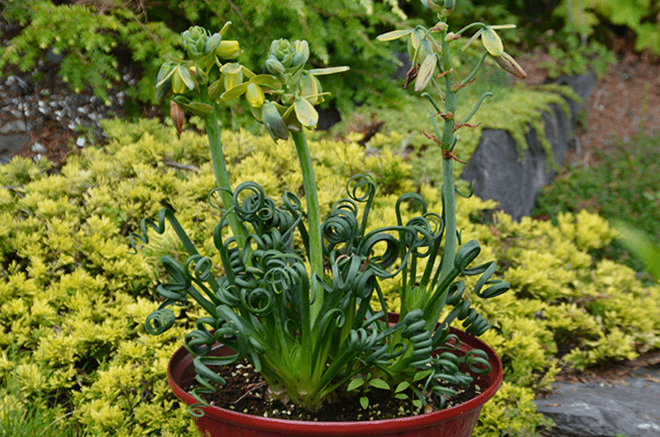
While practically any fertilizer for houseplants will work for this succulent, you should choose one that says “Cactus” on the package. Pachypodium lamerei may grow in this sort of fertilizer since it has all the essential nutrients it needs.
The South African-native bulb succulent Albuca Spiralis, often called Frizzle Sizzle, can reach a height of 8 inches. The distinctive corkscrew-shaped leaves of this plant are long, slender, and attractively dark green. Each leaf possesses glandular hairs that give it a slightly sticky feeling to the touch. Moreover, 10 to 20 substantial, yellow-green flowers with a powerful vanilla scent can bloom on each spike from late Winter to early Spring.
Care
The frizzle sizzle Albuca spiralis is essentially designed for indoor development due to its exceptional and intrinsic timing. This plant can truly grow at a steady temperature! To maintain its content, you’ll still need to be aware of a few things.

Temperature & Light
In its natural habitat, the frizzle sizzling, Albuca spiralis, is used to lots of light. Although full sun is ideal, partial sun might be acceptable as long as it is received frequently. It is definitely vital to get 5-7 hours of full sun, although longer is preferable.
The leaves won’t curl if there is insufficient light; instead, they will only become lengthy and wavy. Consider acquiring a grow light if your home lacks a dependable light source.
Consider placing container-grown plants in a south-facing window or another spot where they will receive plenty of natural sunshine. To make sure that the leaves don’t all face the sun, rotate the plant a quarter turn each day.
Frizzle Sizzle Albuca prefers a minimum temperature of 60 degrees and is not particularly frost resistant. It does, however, need to fall down into colder temperatures throughout the winter months in order to produce healthy seeds. Although it can be cultivated in zones 8 through 11, it does best in 9 to 10. When possible, stay away from completely freezing conditions in the late winter because your plant may suffer.
Keep the temperature between 60 and 75 degrees for optimum growth. This frequently syncs flawlessly with our home climate controls, making maintenance simple!
Water & Humidity
Drainage is essential for growing your Albuca spiralis frizzle sizzle plant properly. While your plant does require water, it also shares the same risk of bulb rot as other bulb plants. Frizzle sizzles require slightly different watering practices from your other plants.
Do you realize that most plants require more water when the heat is on? Albuca, not your frizzle sizzle! The least amount of water is actually required at that time. You want your soil to be at most just damp to the touch from the start of the summer through the majority of the fall. Between watering, let the plant dry out.
Start watering regularly as soon as the weather outdoors turns cooler. Make sure the soil is consistently moist but not saturated. Avoid leaving your pot submerged in water because this might make the soil too damp and lead to bulb rot. Instead, make sure extra moisture can quickly drain away.
Avoid over watering or over-humidifying. The plant’s leaves will become floppy or squishy if there is too much moisture. The plant strives to store water in its leaves, but too much moisture can also prevent the formation of those lovely spirals! Don’t worry about giving your frizzle sizzling plant more dampness. Simply put, Albuca spiralis doesn’t require it.
Soil
You should grow your Albuca spiralis in sandy soil. The frizzle sizzling plant is native to an area of the earth that is naturally sandy, and the bulbs thrive in that soil. It’s acceptable to add a small amount of compost, but avoid adding an excessive amount of material that can trap moisture next to the frizzle sizzling bulb. Albuca spiralis may tolerate insufficient soils.
Consider using an African violet mix combined with a succulent and cactus mix as your base soil, especially if you’re planting in containers, for albuca frizzle sizzling. This offers your albuca spiralis good aeration and exactly the right amount of water retention. The Frizzle Sizzle plant can also thrive on a standard soil that has been supplemented with 50–70% mineral grit.
Mineral grit can be found in great quantities in coarse sand, pumice, or perlite.
Your albuca spiralis normally doesn’t care about the pH of your soil. Most residential soil pH values are favourable for Albuca frizzle sizzling growth. If you can, try to aim for a neutral range, but if you can’t, don’t get upset.
Fertilizer
For your Albuca spiralis, it’s important to fertilize at specific periods of the year. As it enters its active growing season in the late fall, frizzle sizzle needs a good jumpstart. The optimal time to fertilize again after that is when the plant’s flower stems begin to emerge in the spring.
Your albuca frizzle sizzling will grow best with a balanced liquid fertilizer. To make sure your plant is completely hydrated the day before fertilizing, give it a good drink of water. The soil will then receive the liquid fertilizer; the albuca will not. Let any excess drain through the soil.
In the start of the growing season, fertilize once; if necessary, follow it up with a second application a few weeks later. If you’re using a weak organic fertilizer, fertilize once a month during the plant’s development spurt; if you’re using anything stronger than 2-2-2, limit your early application to one or two doses. When you first notice signs of flower stem development, fertilize once more. In the early fall or summer, avoid fertilizing.
Table





